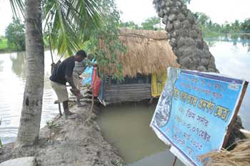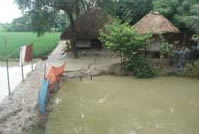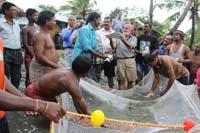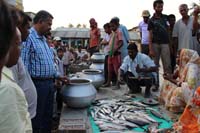
In 2009, Adivasipara Village, Hathkhola (Bali Village No. 9) of Gosaba Block in South 24 Paraganas, West Bengal faced a deadly cyclonic storm called ‘Aila’ which washed away almost the entire island. Intrusion of salt water spoiled freshwater ponds and irrigation channels including their biodiversity. Since then availability of food and livelihood options were the major constraints for the inhabitants of the Island. ICAR-Central Institute of Freshwater Aquaculture, Bhubneshwar had initiated restoration of fish culture activities and livelihood support system of the tribal population in the devastated Island. Availability of quality carp seed, other critical inputs and technology were the major issues. ICAR-CIFA conducted surveys, analyzed soil and water parameters of the ponds, established portable Fiberglass Reinforced Plastic (FRP) carp hatchery for seed production, supplied critical inputs for integrated and composite aquaculture to 51 tribal farm families of Adivasipara Village, demonstrated scientific aquaculture practices in 4.855 ha pond area, imparted regular trainings to the beneficiaries and also became the driving force for bringing several resource persons and dignitaries to the Island.
The first phase (March 2013 ) of the aquaculture demonstration programme covered 22 beneficiary families with 2.56 ha total pond water area, while the second phase (26 July 2013) covered additional 29 beneficiaries with 2.295 ha total pond water area. In 2014, one FRP hatchery unit of 10 lakh spawn production capacity per operation was installed and successfully produced seeds of major and minor carps in the Island. Since then this unit has been working as nucleus for carp seed supply to Bali and other nearby Islands.



Composite fish culture was demonstrated in different phases to 51 tribal farm families with 51 ponds totaling to 4.855 ha water area of the Island. Stocking density of Indian major carps (IMC) such as rohu, catla and mrigal was @6000 nos/ha and the ratio of stocking was 4:3:3 respectively. Bata (Labeo bata) @2,000 nos/ha was also stocked along with the IMC in the culture system. Regular feeding in hanging bamboo baskets was done in ponds. Sinking pellet feed was given @ 1-2% of the body weight of cultured fishes. Regular manuring with raw cow dung @8,000 kg/ha/yr (as equal monthly installments), SSP @400 kg/ha/yr (as equal fortnightly installments), urea @200 kg/ha/yr (as equal monthly installments) was done along with lime application @400 kg/ha/yr (in equal monthly installments). A gap of 15 days was maintained in between lime and SSP applications. Monthly netting was done in ponds to assess the fish growth as well as for bottom racking.
From a benchmark production of around 800 kg/ha/year the beneficiaries could achieve 4.3–4.9 t/ha/yr. Income of Rs. 4.56 lakhs/ha could be achieved by selling fish @120/- per kg. In 2015, critical inputs could not be supplied to these tribal farmers, though that did not dampen their spirits and determination; they produced 3.0-3.5 t/ha/yr fish from their ponds investing in inputs from their personal resources.
In order to increase the productivity and profit per unit pond area, the institute had designed low cost duck houses and 800 ducklings of “Khaki Campbell” variety were provided to 38 beneficiaries of the Island covering 3.0 ha water area in September, 2013. Ducks were vaccinated against plague and cholera. The beneficiaries were provided with feeder, drinker and initial feed for 1 month for the ducks. The ducklings matured and started laying eggs from middle of January, 2014. Through duck-cum-fish culture 38 farm families received a total profit of Rs. 2.8 lakh per year from 3.0 ha pond water area.
The success achieved from the freshwater aquaculture interventions in the Island has developed into a model worth trying for many. Top officials of Forest Department of West Bengal visited Bali Island many times to witness ICAR-CIFA demonstration activities. After observing the marked reduction in entry of tribals in the forests, they realized that fishes in the tank equate money in the bank. Forest Department has adopted other Islands of the Sunderban Delta for aquaculture activities
(Source: ICAR-Central Institute of Freshwater Aquaculture, Bhubaneswar)







फेसबुक पर लाइक करें
यूट्यूब पर सदस्यता लें
X पर फॉलो करना X
इंस्टाग्राम पर लाइक करें